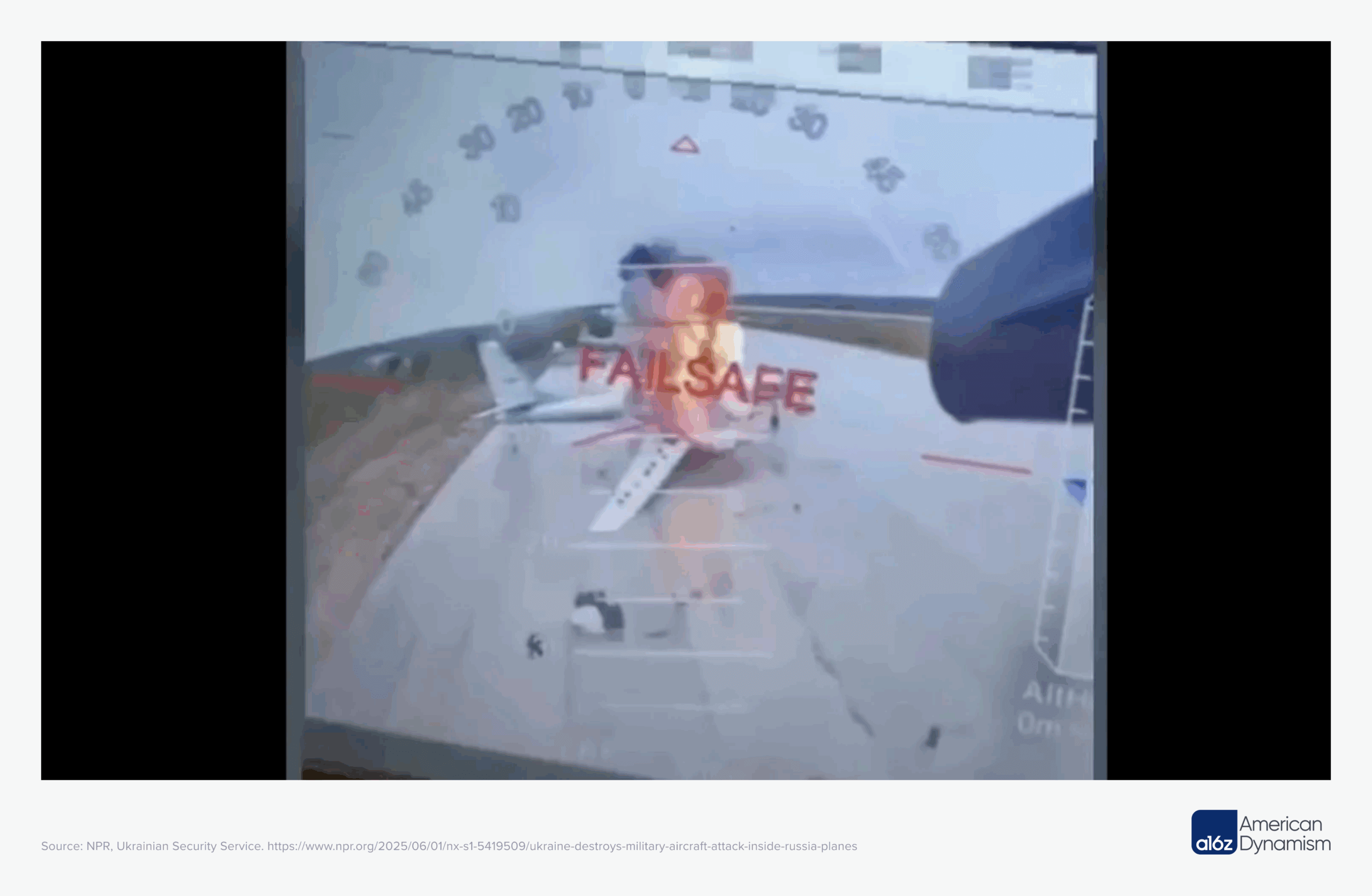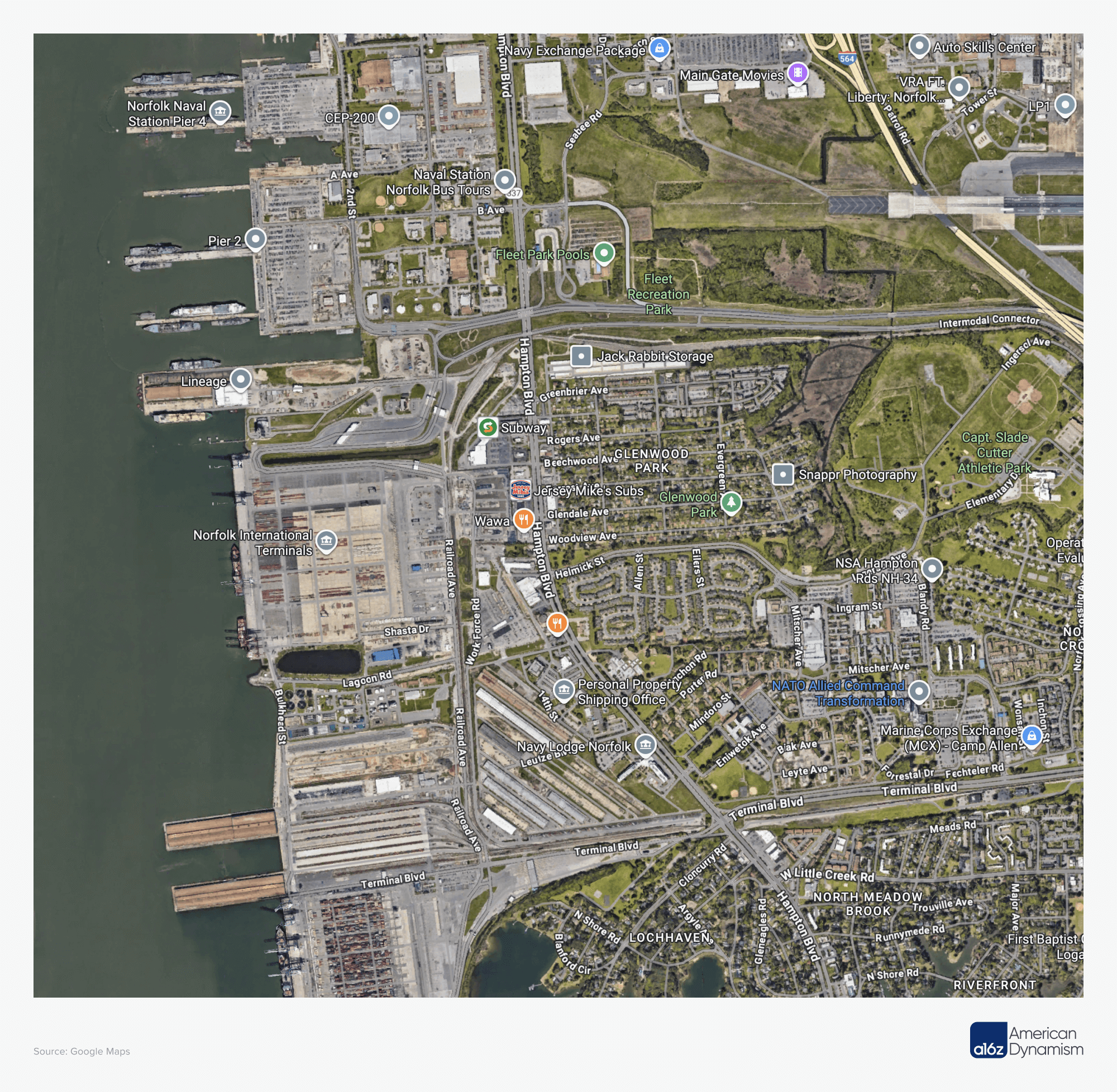This summer, we twice witnessed military history unfold. Ukraine first stunned the world with Operation Spider’s Web, crippling Russia’s strategic nuclear bomber fleet deep within its territory by using commercial drones smuggled in civilian trucks. Weeks later, Israel repeated this feat with Operation Rising Lion, using swarms of locally-deployed small drones to disable Iranian anti-air systems as part of a larger assault on its nuclear weapons program. In both instances, the attackers overwhelmed defenses designed to stop missiles and jets with drones the size of a backpack, dealing devastating blows to their adversaries in the process.

An Iranian surface-to-air missile launcher seen in the crosshairs in a screenshot from a video released by the Israeli Ministry of Defense.
These spectacular attacks were significant victories for the free world. Importantly, there is no evidence that Ukraine and Israel passed notes. Instead, each assessed their respective enemy’s defenses from first principles and reached the same conclusion: smuggled commercial drones offer an asymmetric, highly effective way to devastate an opponent through a surprise attack.
While we should celebrate our partners’ successes, there is a problem: our adversaries clearly realize that we are equally vulnerable to a surprise drone strike.
Drones are an essential technology with extensive commercial, public safety, and military applications. It is imperative that the United States lead the world not only in drone innovation and manufacturing but also counter-drone defense. Unfortunately, America’s homeland is woefully unprepared for a coordinated drone attack. The numbers prove it: there have been over 350 drone incursions over U.S. military bases in the last year alone. As Rear Admiral Paul Spedero testified this year, mass drone incursions show us that “our homeland is no longer a sanctuary.” Our legal authorities and physical defenses remain optimized for Cold War-era threats: ballistic missiles and bombers rather than swarms of cheap, repurposed drones. Put simply, while our chief adversary invested heavily in drone technology, we failed to invest in the laws and equipment needed to protect our nation from this danger.
This is not conjecture. It is reality. Last fall, unidentified drones flew unimpeded for weeks over sensitive military installations and civilian infrastructure in New Jersey. While the government allayed initial concerns, it is telling that U.S. military and law enforcement not only failed to deter the original flyovers despite the imposition of an FAA no fly zone but ultimately admitted that they lacked both the authority and equipment to stop them. A year earlier, drones swarmed over Langley Air Force Base, grounding our most advanced fighter jets for more than two weeks. There have been many other instances of drone swarms seemingly assessing our defenses while the U.S. lacked the means to respond. Drones have also been used to gain intelligence on sensitive defense and military industrial facilities, showing that our nation faces both a surveillance and kinetic threat.
This vulnerability extends to our nuclear triad. Drone incursions in the UK targeted air bases that house our strategic bombers. As witnessed by recent tracking of B-2 Spirit bomber takeoffs and publicly available image searches revealing B-52s sitting in the open, our most valuable aircraft are identifiable on the tarmac and thus targetable by drones. This creates a profound danger for world security. If an adversary believes that it can neutralize a key part of our nuclear deterrent, it may feel emboldened to make a dangerous first strike, conventional or otherwise.
Civilian infrastructure is even more vulnerable. Suspected adversary drones flew unimpeded around the nation’s largest nuclear reactor and other sensitive Department of Energy (DOE) facilities. Similar events have occurred over American “dams, power lines, and nuclear reactors.” While DOE has taken some steps to address these incursions, many critical infrastructure operators remain unprepared for even small-scale drone strikes. That is despite the fact that even a handful of drones can severely disrupt oil and gas pipelines, water treatment, power generation, and air traffic.
The good news is that we still have time. With the right actions, we can close this dangerous gap in our defenses and avoid a 21st century Pearl Harbor-style attack while simultaneously ensuring that our nation has a sufficient drone industrial base to project power and protect against more conventional attacks. The Administration’s recent drone executive orders were an excellent and essential first step. Here is what should follow:
- Clarify and expand authorities to neutralize trespassing drones. Current laws on counter drone operations are fragmented and outdated, leading to slow and ineffective responses. Only a small number of military sites are authorized to engage in counter-drone operations. Public safety agencies must often wait for high-level approval before engaging drones. A legal regime designed for days-long analysis cannot work against drone swarms that can materialize in moments. Current efforts to expand these authorities should be accelerated.Invest in scalable counter-drone technology: As Vice President Vance rightly urged, the U.S. must invest in counter-drone equipment. According to recent DOD testimony, “Bases inside the US often lack even basic equipment to detect drones.” The same is true of high-value civilian sites. The private sector has already developed highly capable solutions that can operate safely in populated areas. When combined, they would create a layered defense of early detection, electronic warfare, and kinetic solutions. This on-the-ground capability would do far more to deter and thwart attacks than “fly-away kits,” which would arrive after the completion of a drone swarm attack. The Pentagon should prioritize these layered drone defenses for INDOPACOM-aligned bases and installations containing strategic air and ballistic platforms, submarines, sensitive intelligence equipment, and vital naval facilities. Purchasing this equipment would be money well spent. As Russia recently learned with the loss of many of their strategic bombers, it is nonsensical to spend billions on expensive defense equipment while refusing to spend a few million to protect them.Protect critical infrastructure. Power plants, ports, pipelines, and water facilities must dramatically upgrade their drone defenses. Many of these facilities sit near key military targets, compounding the risk. At the Port of Virginia—adjacent to Naval Station Norfolk—a drone attack from a container ship could paralyze both economic activity and military operations. One option to rapidly address this need is to provide limited federal funding with phased reductions over five years for infrastructure sites deemed critical to national or economic security.Secure U.S. Drone Technology and Manufacturing Dominance. The ability to identify and neutralize drones necessarily requires a deep understanding of underlying drone technology and manufacturing. Thus, in addition to the many other essential reasons why the United States must be the world’s dominant drone power, it is essential that our nation make this field a national security priority as part of a larger investment in drone security. Building on the Trump administration’s recent executive order aimed at invigorating domestic drone manufacturing, Washington should launch a comprehensive initiative to outpace China in both drone innovation and production. By seizing the technological high ground in unmanned systems, the U.S. will gain a lasting edge that helps deter and defeat emerging drone threats to the homeland.
We have entered a new era of warfare, where surprise and scale defeats static and expensive systems. At Pearl Harbor, carrier-based airpower was used in a new and unexpected way, delivering a blow America never expected. Drone swarms are a similarly disruptive technology to both military doctrine and homeland defense. The future is written in the past for those willing to read it and our adversaries are undoubtedly studying the success of the Ukrainian and Israeli drone strikes. The only question left is whether we will act fast enough to deny them the same success.
</div>


